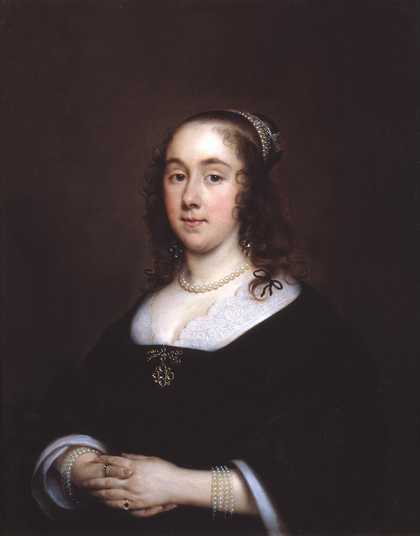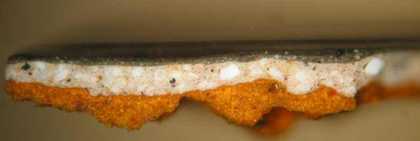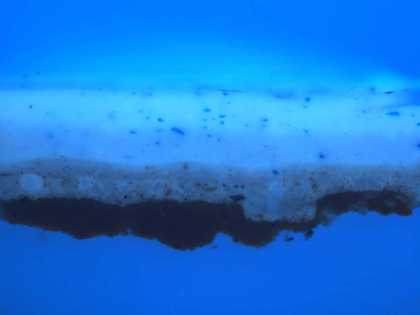
Fig.1
Cornelius Johnson 1593−1661
Portrait of an Unknown Lady
1646
Oil paint on canvas
794 x 641 mm
N02530
This painting is in oil paint on canvas measuring 794 x 641 mm. The linen has a coarse, plain weave with an average of 12 vertical and 13.6 threads per square centimeter (fig.2). There is slight cusping on the left and lower edges but it is absent from the top and right.1 While this might mean that the canvas was cut from a larger, pre-primed piece, the truncated inscription in the lower right corner (the ‘it’ from ‘fecit’ is missing) indicates that the canvas has been reduced in size at that edge and probably at the top too.

Fig.2
X-radiograph of Portrait of an Unknown Lady
The ground is grey and was applied as a double layer (figs.3 and 4). The first application was with opaque, bright tawny orange colour, which contains mainly an orange coloured earth pigment, black and chalk bound together in oil.2 The second coat is opaque pinkish beige and it contains lead white, vermilion, black, yellow earth pigments and glassy particles.

Fig.3
Cross-section through the background, photographed at x250 magnification. From top to bottom it shows: opaque orange ground; opaque beige ground; opaque brownish grey paint; darker greenish paint

Fig.4
The same cross-section photographed in ultraviolet light
Inspection with magnification and with infra-red reflectography revealed no traces of underdrawing but it is likely that the artist laid in the likeness and costume with sketchy dead colouring.3 The visible painting was worked up with relatively thin paint applied in several layers with some low impasto in lace and highlights of jewellery and semi-translucent glazes on top. There is much soft wet-in-wet blending of the tones on the picture surface, especially in the flesh tones to create rosy cheeks and areas of highlight and shadow. Details such as pearls were applied on top after the underlying paint was touch-dry (figs.5 and 6).

Fig.5
Cross-section through the pearl bracelet, photographed at x360 magnification. From bottom to top it shows: opaque orange ground; opaque beige ground; two flesh tones, blended together wet-in-wet; thick white lead of pearl, incorporating blue pigment

Fig.6
The same cross-section photographed in ultraviolet light
October 2003
